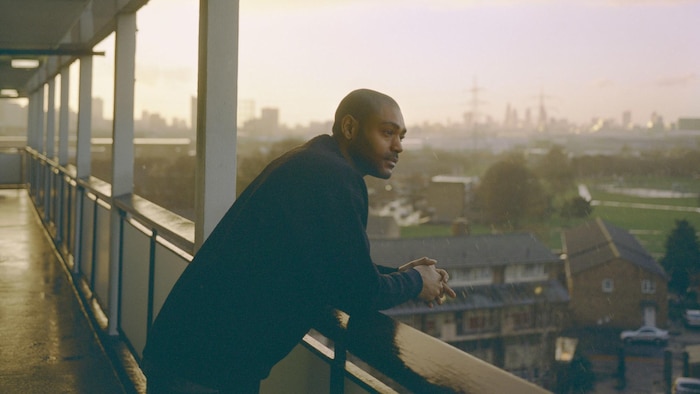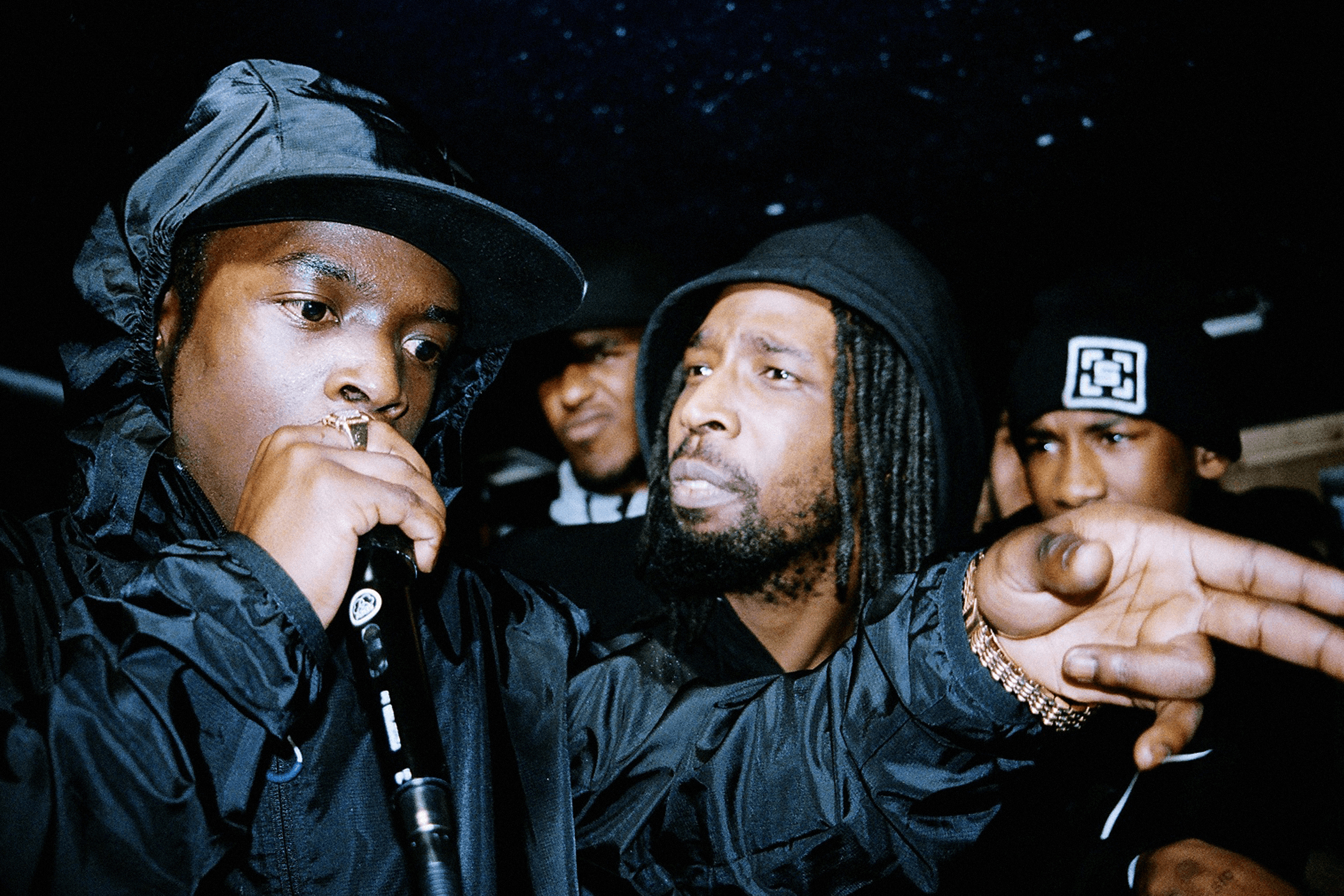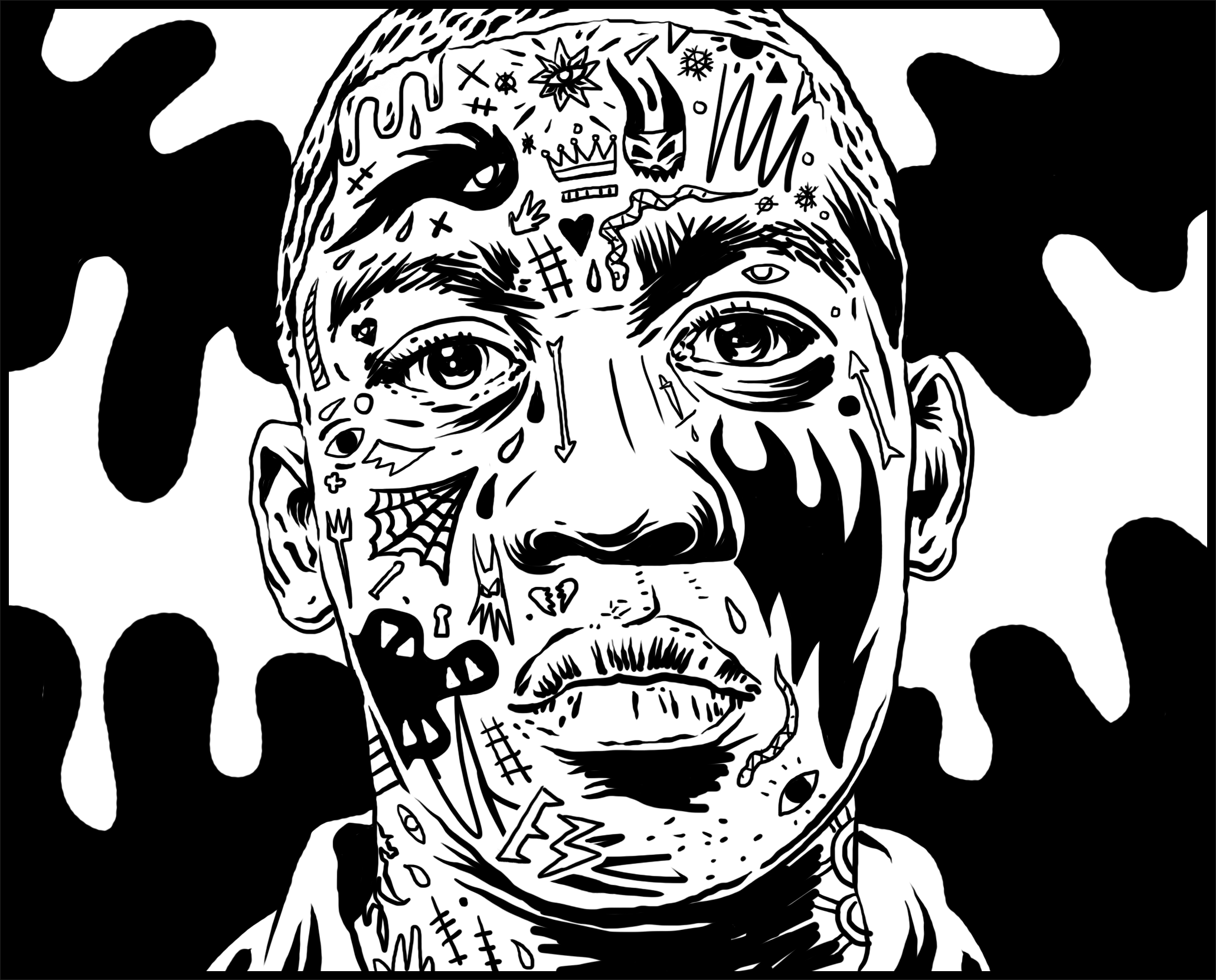Interview: Kano
Lauren Martin speaks to the east London icon about his life in grime for RBMA Radio

One of grime’s most distinctive voices, Kano has been a key figure in the genre since its earliest days. An east London native whose Jamaican family brought him up with reggae music and soundsystem culture, Kano went his own way as a teenager, linking up with the N.A.S.T.Y. crew alongside artists like Jammer and D Double E. The affiliation boosted his profile, enabling Kano to go solo and eventually drop his 2004 debut single “P’s & Q’s” which became an underground anthem and marked him as a rising star.
The record was released by stalwart indie label 679, which also issued his 2005 debut album, Home Sweet Home, and its 2007 follow-up, London Town. However, Kano’s desire to return to his grime roots ultimately led him to do it alone for his next two LPs, 140 Grime St and Method To The Madness, which both surfaced via his own Bigger Picture Music imprint.
Along the way, he collaborated with artists like Mike Skinner, Damon Albarn, Craig David, Hot Chip, Vybz Kartel and Wiley, amongst many others, and also ventured into the world of acting, appearing in several movies and the television series Top Boy.
Although he’s spent less time in the spotlight in recent years, Kano has continued to drop the occasional mixtape and new track, and the 2016 release of his long-awaited fifth album, Made In The Manor, looks to complete his comeback effort.
In this excerpt from Kano’s Fireside Chat on RBMA Radio, Lauren Martin speaks to the grime figurehead about some of the key moments in his career so far.
You have a lyric on your new song “New Banger” that says that your family were “the first blacks in the Canning Town flats.” Canning Town, in east London, was a known place for the National Front in the ’70s. What was your family’s experience of coming to London from Jamaica?
My nan came to England from Jamaica in the late ’60s or early ’70s, and came straight to Canning Town. She used to work in a factory, and she sent for my mum when she was around 6 years old. Coming from Jamaica to Canning Town must’ve been a massive culture shock. She told me that when they docked in Southampton, it was snowing, and they’d never seen snow before. They thought it was sugar.
I do have that lyric in “New Banger”: “the first blacks in the Canning Town flats.” Canning Town was a really white area. I imagined it to be heavily racist at the time. They used to call my mum “Cassius” because she used to fight so much. She’d have to fight to be allowed to take a certain route to school.
That’s when people have had enough, and they say, “Do you know what? I’m not going to stand for it no more.” It was tough back then. Other families from Jamaica and the West Indies, like Dominique or in St. Lucia, also moved to east London, but also to Brixton. I remember my mum saying that she had to travel to Brixton to buy the Jamaican food that she wanted.
The black families that did move to east London got to know each other and started to build strong bonds and friendships. They stuck together. Even now, when I’m in Canning Town, there are people my age that I know, and my parents know their parents and our grandparents.
Those roots are the reason that I am the artist I am now. I have that strong east London feeling throughout my music. It was the birthplace of grime music, but I also have my influence of Jamaican dancehall music, because we used to go back every year for the summer holidays.
When I was a bit older, I used to buy 7-inch records and go to dancehall shows. I remember seeing an artist called Tiger, in particular. That’s the reason I’ve gone to work with like Vybz Kartel and Elephant Man. That’s the path that my family have taken, and you see it in my music.
What was your own experience of growing up in London? Was your idea of England different to that of your parents and grandparents?
My experience of growing up in England was really different to that of my mum and my family. When I was born we were still living in Manor Road, and then shortly after we moved to East Ham, where I went to primary and secondary school, called Langdon. It was very multicultural. I want to say that it was, in the majority, Asian kids, but there were white and black kids too: lots of African and West Indian backgrounds.
We didn’t really travel too much outside of east London. When I got into football, I used to play for Chelsea, and then I played for Norwich. I started to travel to whiter areas, like Essex, and then when I started making music, I’d travel to north and south London. I started to get a feel for the landscape of the city.
Tell be about the early days of N.A.S.T.Y. Crew, and your introduction to MCing.
Before getting involved in N.A.S.T.Y. Crew, I was MCing and producing tunes. My brother got decks for his 16th birthday – I was 14 years old – and we used to make tapes at home to give to our mates at school. My brother got on a radio station called Flavour, which is in Canning Town, and I used to MC on air while he was DJing. We used to buy records on the weekends in a shop called Paul’s Music in Whitechapel, too.
I had a keyboard and a program called Cubase, and I just used to mess about. I was – and still am – a big fan of D Double E. He was to me what Jay-Z is like to kids in Brooklyn. I got to make a tape with him once, in my brother’s bedroom. We had a mate called Ginger who lived in East Ham. D Double E told us that he was going to come down one day, and I thought it was never going to happen, but he turned up (about five hours late, though). I think he had a Golf GTI at the time. He was the coolest guy ever: Golf GTI, haircut like box, and a Nokia phone. He was a superstar in the ends.
I had another mate called Demon that I knew from young. He lived on Corporation Street in Plaistow, which is just around the corner from Manor Road and where Mak 10 and Marcus Nasty are from, too. Demon was also in my district football team, Newham, and he knew Sharky Major. When N.A.S.T.Y. Crew started out, it was just Mak 10, Sharky and Stormin. They started recruiting a couple more MCs, like D Double E, and then they asked me if I wanted to be in the Crew. The Crew was all local MCs that I used to listen to on the radio, so we linked up and joined the radio show on Deja Vu: every Monday night, from 8PM to 10PM.
What was the preparation for each radio show like? Pirate radio was notoriously ad hoc, but you must have had your ways of working and ideas about how to develop the sound of the Crew?
Since Mak 10 was the DJ, we’d create a playlist of the music he might play on a laptop. Then he’d go to the pressing plants, cut the dubplates, and then bring them home and test them out. It really was that time, you know? We’d occasionally go round his house and practice together, but other than that, everyone used to practice individually.
Me and Sharky used to link up and write lyrics together. I didn’t write with anyone else. He lived in Barking, which isn’t too far from me, so he used to bring his writing book up to mine. I had my own writing book, too: it was yellow, my English “rough book” from school; then we’d sit and write together. We’d feed each other lines and sit in silence for time. It was our craft.
The difference between then and now is that, now, I only write lyrics for a reason: if I’ve got to do a feature verse for this person, or finish a verse for my own tracks. Then, we wrote lyrics for fun. I used to do it every single day: lyrics, lyrics, and more lyrics. Then, I was using pen and paper. I don’t really use pen and paper anymore, but there was something quite beautiful about just having a book full of lyrics.
That’s so interesting that you would write to no beats. What music were you thinking of when you were writing? Did you have an ideal sound in mind? It was an important time – garage, jungle, hip hop, drum and bass and grime were growing in different directions.
Sharky and me would write lyrics over any beat. People would probably call it grime now, but that wasn’t even a phrase back then. It would be roughly 138-140BPM, because that’s the tempo Mak 10 would play in his sets, but we could never attach our lyrics to any “style” of music because we had no idea what he’d pull out of the bag. We’d go to a rave with loads of lyrics in our head, ready for any beat. I only started writing lyrics for a specific piece of music when I made “Boys Love Girls.”
I think the beauty of N.A.S.T.Y. was that we all brought something different to the crew. I always viewed us as the Wu-Tang Clan of grime.
I think that practice has affected me. Now, when I write lyrics, I don’t need music playing in the background. I familiarize myself with the music, but then turn it off pretty quickly. I could be in bed, or driving, and another piece of music could be playing, but I could still write.
N.A.S.T.Y. Crew were one of the main grime crews in London at the time, but there were other crews who were as well know, too: different characters, different sounds. What was the dynamic like between the crews, and how did you view their strengths and weaknesses?
Back then, it was us (N.A.S.T.Y. Crew), More Fire Crew, Roll Deep and East Connection. (Ruff Sqwad and others came a bit later on.) We had the 8-10PM slot on Deja Vu, and I think that Roll Deep had the 6-8PM slot, and East Connection may have been on after us. We were all back to back to back. There was always an overlap of when the next crew would turn up 10 minutes early, to check our vibe. We’d always say, “Oh, we better put our best into it” when they did.
I think the beauty of N.A.S.T.Y. Crew was that we all brought something different to the crew. D Double E is unique – a real character. Sharky Major brought those deep lyrics, Arma brought that Jamaican vibe, and Stormin was the bubbly personality that worked well in the raves. He was always the first to grab the mic and hype the crowd, in any situation. I also used to really like working with Ghetto. We became a double team. I always viewed us as the Wu-Tang Clan of grime.
I think that Roll Deep brought a different sort of entertainment to it. Obviously, Wiley is partially responsible for creating the sound, and is credited as the godfather of grime – and rightly so. Then Dizzee Rascal came through. He wasn’t really part of Roll Deep, but he was heavily affiliated with them. They had a superstar in Dizzee.
More Fire Crew always brought excitement and Lethal B was known for making bangers, like “Oi” and “Pow.” East Connection – I’d say that they brought business to the table, because they used to put on the raves in EQ and the Rex, and Diesel started running Deja Vu. There was definitely a friendly competitiveness between us that you could even call a rivalry, but it was all good for the sport.
When you released your debut album, Home Sweet Home, in 2005, it was an interesting time for grime music. Dizzee Rascal’s Boy in da Corner had won the Mercury Prize two years before, and he was becoming a major star. Wiley’s Treddin’ on Thin Ice came out in 2004, but wasn’t the commercial success that perhaps he and the scene had been hoping for. When you released Home Sweet Home, what did you think of the scene and your place within it as a grime MC releasing a debut album?
Honestly? Making my debut wasn’t a daunting experience. I made “Boys Love Girls” before I joined N.A.S.T.Y. Crew. When it came to me doing an album, I showed Wiley some tunes I was working on and he was like, “You’re going to make an album. Look mate, just put them six tunes on a CD, add a few more, and that’s your album, bro.” I was like, “Really, it’s that simple?” Then when Dizzee released Boy in da Corner, he showed us all that it was possible.
Before I signed my album deal, I had 70% of the music already made. I didn’t have any expectations. Just having an album out was good enough for me. I was and still am really proud of Home Sweet Home. As soon as it dropped, I went on tour with The Streets, and I gained momentum, but it took a long time for me to build it up.
Home Sweet Home went gold, but what people don’t know is that it took so long to go gold that I actually got a silver plaque. (Normally, when albums are selling, they don’t send you the silver one because they know it’s going to reach gold anyway.) Even though it took some time, that album was a big step for the grime scene.
I remember that people were like, “He’s the one. If it don’t work with him, then it’s never going to work and we’re all finished.” A lot was riding on it, but at least I didn’t have to make the music with that on my shoulders. That pressure came from the outside, after it was released. I couldn’t have made it under that pressure.
One thing that’s always struck me about you is your immediate willingness to collaborate with others on your albums – Fraiser T. Smith, Damon Albarn, Mike Skinner. Treddin’ on Thin Ice and Boy in da Corner were very much solo efforts. How do you feel about the collaborative relationships you’ve built up over time?
My approach to making albums has been to work with the best people that are available to me: people that I like, gel with and are up for making music with no boundaries. I don’t look at my albums as grime albums, so I never approach it that way. I think I’ve brought eclecticness to the game. I don’t want to restrict myself to a tempo. I want to fuse hip hop, dancehall, grime – lots of genres.
You’ve said before that your lyrics are very thematically narrow, because you focus on your life in London, but your musical tastes are very broad. How have you worked through that over the years?
When I set out to make Made In The Manor, I was very aware that I now have a lot more to say than in previous albums. I’ve done so much, and have been to so many places, and I still I want to experiment and push boundaries, but I didn’t want it to sound like a project that was all over the place.
At the moment, my thing with music is that it feels like everyone is spitting on the same beat, and I didn’t want to be like that, so I was like, “Do you know what? I’m going to showcase my influences and my willingness to experiment, but lyrically, I’m going to reel it in. I’m going to really talk about me, my friends, my family and where I come from.”
Lyrically, it’s a small world, but musically I’ve opened it up. Made In The Manor has a grime DNA, even though it’s not all hard 140BPM beats. I’m describing the environment and the times, but it’s not what you’d call quintessential grime music.
Recently, Wiley said that he feels that you’re one of the most underrated grime MCs of all time. How do you feel about the idea of being “rated”?
It’s interesting, because success to me is not necessarily success to another artist, or that young kid coming up. I don’t need to be in your face, on TV, every moment. I don’t need to feel famous to feel successful. I am more interested in becoming better than becoming bigger. When Wiley says something like that – I’ve heard it millions of times, but I’m clearly not the most underrated. If you say that, you do rate me. I believe that my peers rate me highly. I believe I am rated.
Maybe “underrated” isn’t the right word – “undervalued,” maybe? Do I feel I can do more? Yeah, I feel like I can. But look at it like this. Ten years, five albums, half a dozen mixtapes, however many featured verses, hundreds of videos, loads of tours – and people say that I still haven’t done enough.
It’s difficult to understand where people are coming from, but take it with a pinch of salt. It’s usually out of love. I don’t feel I’ve reached my potential yet, though. One day, maybe I’ll look back on and enjoy the career that I’ve had. At this moment in time, though, it’s just about more quality music. That’s what I’m interested in.

